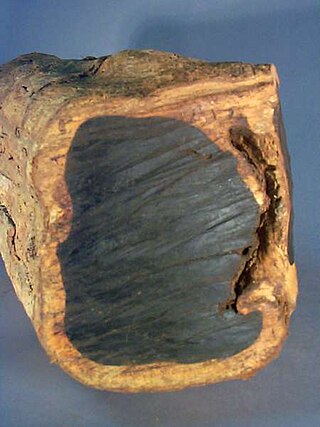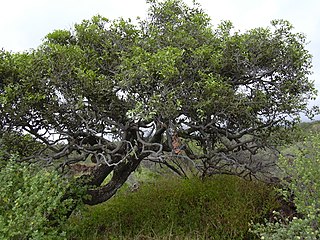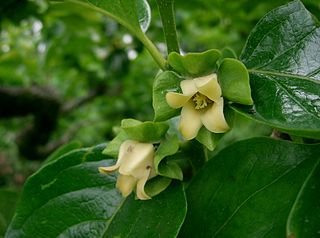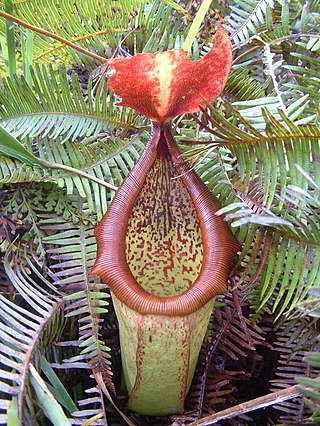
The persimmon is the edible fruit of a number of species of trees in the genus Diospyros. The most widely cultivated of these is the kaki persimmon, Diospyros kaki – Diospyros is in the family Ebenaceae, and a number of non-persimmon species of the genus are grown for ebony timber. In 2019, China produced 75% of the world total of persimmons.

Ebony is a dense black/brown hardwood, coming from several species in the genus Diospyros, which also includes the persimmon tree. Few Diospyros species such as macassar and mun ebony are dense enough to sink in water. Ebony is finely textured and has a mirror finish when polished, making it valuable as an ornamental wood. It is often cited as one of the most expensive woods in the world.

The Ebenaceae are a family of flowering plants belonging to order Ericales. The family includes ebony and persimmon among about 768 species of trees and shrubs. It is distributed across the tropical and warmer temperate regions of the world. It is most diverse in the rainforests of Malesia, India, tropical Africa and tropical America.

Diospyros is a genus of over 700 species of deciduous and evergreen trees and shrubs. The majority are native to the tropics, with only a few species extending into temperate regions. Individual species valued for their hard, heavy, dark timber, are commonly known as ebony trees, while others are valued for their fruit and known as persimmon trees. Some are useful as ornamentals and many are of local ecological importance. Species of this genus are generally dioecious, with separate male and female plants.

Diospyros virginiana is a persimmon species commonly called the American persimmon, common persimmon, eastern persimmon, simmon, possumwood, possum apples, or sugar plum. It ranges from southern Connecticut to Florida, and west to Texas, Louisiana, Oklahoma, Kansas, and Iowa. The tree grows wild but has been cultivated for its fruit and wood since prehistoric times by Native Americans.

Diospyros melanoxylon, the Coromandel ebony or East Indian ebony, is a species of flowering tree in the family Ebenaceae native to India and Sri Lanka; it has a hard, dry bark. Its common name derives from Coromandel, the coast of southeastern India. Locally it is known as temburini or by its Hindi name tendu. In Odisha, Jharkhand, and Assam, it is known as kendu. In Andhra Pradesh, and Telangana it is known as tuniki. The leaves can be wrapped around tobacco to create the Indian beedi, which has outsold conventional cigarettes in India. The olive-green fruit of the tree is edible.

Diospyros mespiliformis, the jackalberry, is a large dioecious evergreen tree found mostly in the savannas of Africa. Jackals are fond of the fruit, hence the common names. It is a member of the family Ebenaceae, and is related to the true ebony and edible persimmon.

Diospyros nigra, the black sapote, is a species of persimmon. Common names include chocolate pudding fruit, black soapapple and zapote prieto. The tropical fruit tree is native to Mexico, Central America, and Colombia. The common name sapote refers to any soft, edible fruit. Black sapote is not related to white sapote nor mamey sapote. The genus Diospyros has numerous other fruit bearing tree species in addition to the persimmons and black sapote.

Nepenthes insignis is a tropical pitcher plant endemic to New Guinea and surrounding islands. The specific epithet insignis is Latin for "distinguished" or "remarkable".

The Limahuli Garden and Preserve is a 17-acre botanical garden (6.9 ha) and 985-acre nature preserve (399 ha) on the north shore of Kauaʻi island, Hawaiʻi. It is one of the five gardens of the non-profit National Tropical Botanical Garden.

Diospyros kaki, the Oriental persimmon, Chinese persimmon, Japanese persimmon or kaki persimmon, is the most widely cultivated species of the genus Diospyros. Although its first botanical description was not published until 1780, D. kaki is among the oldest cultivated plants, having been in use in China for more than 2000 years.

Diospyros blancoi,, commonly known as velvet apple, velvet persimmon, kamagong, or mabolo tree, is a tree of the genus Diospyros of ebony trees and persimmons. It produces edible fruit with a fine, velvety, reddish-brown fur-like covering. The fruit has a soft, creamy, pink flesh, with a taste and aroma comparable to peaches.
The Giardino Botanico della Scuola Media Statale "E.Toti" di Musile di Piave is an arboretum and botanical garden located on the grounds of the middle school "E. Toti", Via Guglielmo Marconi, Musile di Piave, Province of Venice, Veneto, Italy. It is open daily.

Pachylemur is an extinct, giant lemur most closely related to the ruffed lemurs of genus Varecia. Two species are known, Pachylemur insignis and Pachylemur jullyi, although there is some doubt as to whether or not they may actually be the same species. Pachylemur is sometimes referred to as the giant ruffed lemur, because although it and the living ruffed lemurs had similar teeth and skeletons, Pachylemur was more robust and as much as three to four times larger. DNA studies have confirmed a sister group relationship between these two types of lemur. Like living ruffed lemurs, Pachylemur specialized in eating fruit, and was therefore an important seed disperser, possibly for tree species with seeds too large for even ruffed lemurs to swallow. In the spiny thickets of southwestern Madagascar, they were also likely to have dispersed seeds evolved to attach to fur and be carried away. Unlike ruffed lemurs, the fore- and hindlimbs of Pachylemur were nearly the same length, and therefore it was likely to be a slow, deliberate climber. However, both used hindlimb suspension to reach fruit on small branches below them.

Diospyros texana is a species of persimmon that is native to central, south and west Texas and southwest Oklahoma in the United States, and eastern Chihuahua, Coahuila, Nuevo León, and Tamaulipas in northeastern Mexico. Common names include Texas persimmon, Mexican persimmon and the more ambiguous "black persimmon". It is known in Spanish as chapote, chapote manzano, or chapote prieto, all of which are derived from the Nahuatl word tzapotl. That word also refers to several other fruit-bearing trees.
Cryptotermes bengalensis, is a species of dry wood termite of the genus Cryptotermes. It is native to India, Bangladesh, Thailand and introduced to Sri Lanka. It is found in dead and rotten wood of Ficus species. It is a pest of Diospyros insignis.













